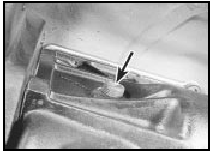Manual gearbox oil level check (Every 12 000 miles (20 000 km) or 12 months)
1 Place the vehicle over a pit, or raise and support it at front and rear. The vehicle must be level for an accurate check.
2 If the gearbox is hot after a run, allow it to cool for a few minutes. This is necessary because the oil can foam when hot and give a false level reading.
3 Wipe clean around the filler/level plug.
Unscrew the plug and remove it (see illustration).

18.3 Gearbox filler/level plug location (arrowed) - N type gearbox
4 Using a suitably marked piece of bent wire as a dipstick, check that the oil level is as shown in the table at the top of this page, according to gearbox type.
5 Top-up the level if necessary, using clean oil of the specified type. Do not overfill, as this can lead to leakage and difficult gear changing. Allow excess oil to drip out of the filler/level hole if necessary. Refit and tighten the filler/level plug on completion.
6 The frequent need for topping-up can only be due to leaks, which should be rectified.
The most likely sources of leaks are the rear extension housing and input shaft oil seals.
7 No periodic oil changing is specified, and no drain plug is fitted.
Hinge and lock check and lubrication (Every 12 000 miles (20 000 km) or 12 months)
1 Work around the vehicle, and lubricate the bonnet, door and tailgate hinges with a light machine oil.
2 Lightly lubricate the bonnet release mechanism and exposed sections of inner cable with a smear of grease.
3 Check the security and operation of all hinges, latches and locks, adjusting them where required. Where applicable, check the operation of the central locking system.
4 Check the condition and operation of the tailgate struts, renewing them if either is leaking or is no longer able to support the tailgate securely when raised.
See also:
Throttle cable - removal, refitting and adjustment
Removal
1 Disconnect the battery negative lead.
2 Working inside the vehicle, remove the
lower facia panel from the driverís side.
3 Prise off the securing clip and disconnect
the end of the thro ...
General information
The 2.0 litre DOHC (Double OverHead
Camshaft) engine was introduced in August
1989 to replace the 2.0 litre SOHC engine
used previously in the Sierra range. The
engine is of four-cylinder, in-line ...
Major body damage - repair
Where serious damage has occurred or
large areas need renewal due to neglect, it
means that completely new sections or panels
will need welding in, and this is best left to
professionals. If the d ...
